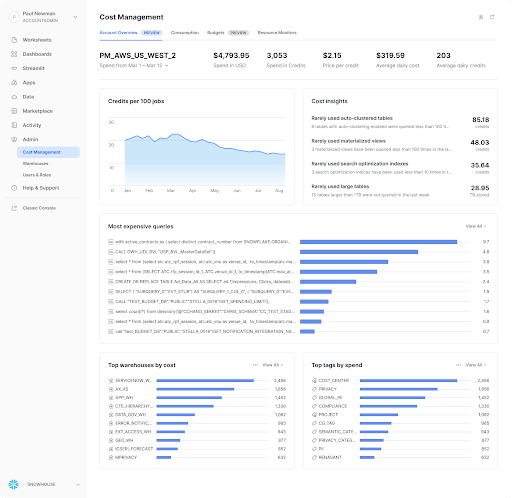The best way to increase the efficiency of a cloud data warehouse is to effectively manage resources, especially when it comes to credit consumption. In the case of Snowflake Cloud Data Platform, keeping tabs on credit usage is pivotal for budgetary control. This article explores strategies to monitor Snowflake credits so you can track credit consumption, curb unnecessary expenses, and make the solution even more cost efficient.
(Note: In order to leverage these features, the user will need access to the ACCOUNT ADMIN role.)
How Snowflake Credits Work
First, let’s start with a basic understanding of how Snowflake credits work.
Snowflake operates on a credit-based system; every operation performed in the platform incurs a specific Snowflake credit cost. Various activities consume these credits, such as querying, data loading, and storing data. The challenge lies in efficiently managing these credits to avoid unexpected costs and stay within budgetary constraints.
Each edition and region of Snowflake incurs a different cost per credit. Check out the Snowflake pricing guide for more information on the Snowflake cost per credit and Snowflake pricing model.
Strategies for Monitoring Snowflake Credits
Now that you understand how Snowflake credits work, let’s explore strategies for monitoring Snowflake credits to help you track consumption and proactively manage costs.
There are four main areas to consider: usage tracking and reporting, resource allocation and scaling, query optimization, and data storage management. We’ll walk through them one by one and share strategies to implement in each area.
1: Usage Tracking and Reporting
- Use Snowsight Visualizations: Snowflake offers several visualizations in Snowsight to help you monitor and manage costs. Go to the Admin dropdown under Cost Management to see data storage breakdown and warehouse credit burn over various time frames.

- Utilize Additional Snowflake Tools: Snowflake offers a range of powerful tools within the ACCOUNT_USAGE schema, providing valuable insights into credit utilization. Employ queries against this schema to extract detailed information on credit consumption, including query execution times, data loading activities, and storage usage.
- Implement Scheduled Reports for Strategic Insights: Establish a regular reporting system to monitor credit consumption trends. Analyze historical data to identify patterns and peaks in credit usage. This proactive approach helps in making well-informed decisions regarding resource allocation and optimization. Many teams find success in utilizing the data from the ACCOUNT_USAGE schema to create visualization reports within popular BI tools like Sigma, PowerBI, and Tableau.
2: Resource Allocation and Scaling
- Track Resource Usage: Set up robust monitoring mechanisms to track resource usage. Monitor compute and storage separately to gain insights into their individual impacts on credit consumption. This visibility allows for targeted optimizations. Create these resource monitors directly within Snowsight or through Snowflake data on any third-party reporting software. Connecting these reports to a messaging platform (Slack, Teams, etc.) or setting up email notifications often improves team workflows.
- Maximize Efficiency with Auto-suspension and Auto-resume: Leverage Snowflake’s auto-suspension and auto-resume features to automatically pause compute resources during idle periods. This proactive approach minimizes credit consumption when resources are not in active use, ensuring cost efficiency. These features come by default on all warehouses upon provisioning.
3: Query Optimization
- Utilize Snowflake’s Query Profiling Tools: Make the most of Snowflake’s query profiling tools to identify inefficient queries. Analyze query execution plans to pinpoint bottlenecks and areas for optimization. Query profiling is available for any query run on your warehouse. It breaks down the query into stages, analyzing each step individually to reveal the breakdown of time and computation for each of those steps. This method effectively pinpoints inefficiencies in your queries that contribute to unnecessary credit consumption.
- Analyze Query History for Credit-Intensive Operations: Identify frequently executed queries or those consuming excessive resources, optimizing them for improved performance and reduced credit usage. You can access the query history in three ways: from the Query History page in Snowsight, using the QUERY_HISTORY view in the ACCOUNT_USAGE schema, or within the QUERY_HISTORY table functions in the Information schema. This approach helps pinpoint which users, queries, or processes are consuming the most credits.
- Implement Query Optimization Techniques: Apply optimization techniques such as query rewriting, efficient use of indexes, and minimizing data movement across clusters. These practices contribute to significant reductions in credit consumption.
4: Data Storage Management
- Assess Data Storage: Regularly assess data storage to identify redundant or infrequently accessed data. Consider archiving or deleting data that doesn’t contribute to active operations in order to optimize storage costs.
- Enhance Storage Efficiency: Leverage Snowflake’s clustering feature to physically organize data. This will reduce the need for excessive storage and enhance query performance. You can also utilize data sharing to efficiently distribute and access data without duplicating storage costs.
Snowflake’s Unique Credit Management Features
Snowflake’s credit management stands out due to several unique features including:
- Zero Copy Clone: This feature enables you to create clones of data without incurring additional storage costs. It’s particularly useful for testing, development, and creating isolated environments without impacting credit consumption.
- Multi-Cluster Warehouses: Snowflake’s separation of compute and storage allows users to independently scale compute resources, offering flexibility in managing credit utilization during peak demand periods. It ensures efficient allocation of resources based on varying workload requirements.
How Snowflake Differs from Other Options in Credit Budgeting
Snowflake differs from its counterparts in several ways regarding credit management:
- Transparency and Granularity: Snowflake provides detailed insights into credit utilization, offering transparency and granularity in tracking credit consumption. This visibility enables better-informed decisions for optimizing usage and managing costs.
- Compute-Storage Separation: The distinct separation of compute and storage resources gives users flexibility in scaling resources independently. This separation allows for precise control over credit utilization based on specific workload demands so you can effectively optimize costs.
Your Cheat Sheet for Snowflake Cost Optimization
Efficient credit monitoring and management are pivotal for Snowflake cost optimization and resource utilization. By implementing these strategies and leveraging Snowflake’s unique features, you can gain better control over consumption of Snowflake credits to reduce unnecessary spending and effectively manage budgets within the Snowflake ecosystem.
Need help with Snowflake? Data Clymer has deep expertise implementing and optimizing Snowflake at organizations of all sizes and across a wide variety of industries. Explore our Snowflake consulting services or contact us for a free data strategy assessment.





